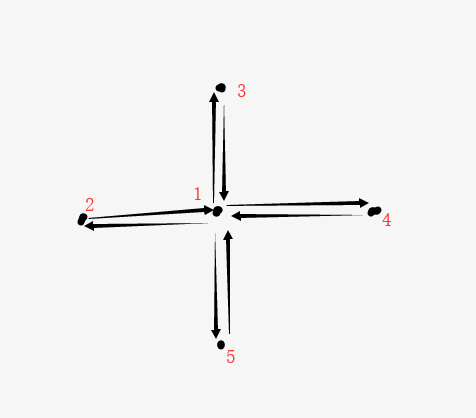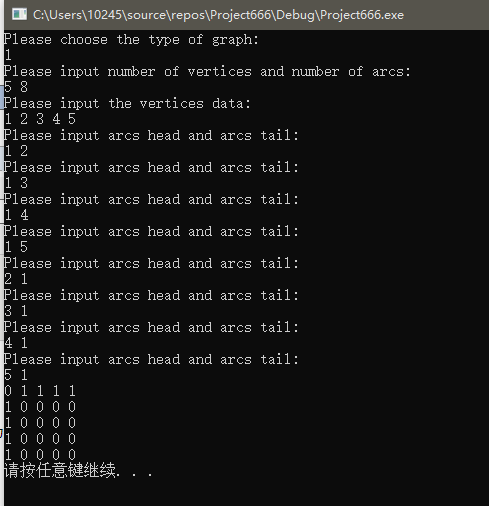图的顺序存储结构
对于图的存储,只要理解其中一个,对于其他的理解自然也就理解了。
有向图与无向图:无向图相对于有向图,就是将有向图矩阵关于主对称轴对称。在数据存储时,多进行一次,横纵坐标交换存储的过程。
有向网和无向网同有向图和无向图:多出的仅仅是权值的村储,也就是将位置关系判断的变量存储权值。(实际上,我们表示图的方式,可以理解为权值为1)

#include <iostream> #define MAX_SIZE 20 using namespace std; typedef struct A { int Adj;//用来表示有向图无向图顶点之间的关系;表示有向网和无向网顶点之间的关系以及权值大小 //int* InforPointer; }TT[MAX_SIZE][MAX_SIZE]; struct Graph { int Vertex[MAX_SIZE];//顶点数据集合 int vertex, arcnum;//顶点和边的数量 TT RT; }; int checkfunc(Graph* G, int n) {//检查我们输入的弧头弧尾(实际上就是顶点),在我们存储的顶点集合中存在 for (int i = 0; i < G->vertex; ++i) if (G->Vertex[i] == n) return i; return -1; } void Digraph(Graph * G)//有向图 { cout << "Please input number of vertices and number of arcs:" << endl; cin >> G->vertex >> G->arcnum;//顶点数以及边数 cout << "Please input the vertices data:" << endl; for (int i = 0; i < G->vertex; ++i) cin >> G->Vertex[i];//顶点集合的数据(就是顶点的序列号:1号顶点,2号顶点...) for (int i = 0; i < G->vertex; ++i) for (int j = 0; j < G->vertex; ++j) { G->RT[i][j].Adj = 0;//将矩阵置空(全部为0) //G->RT[i][j].InforPointer = NULL; } for (int i = 0; i < G->arcnum; ++i) { int head, tail;//弧头和弧尾 cout << "Please input arcs head and arcs tail:" << endl; cin >> head >> tail; int m = checkfunc(G, head);//检查顶点是否存在 int n = checkfunc(G, tail); if (m == -1 || n == -1) { cerr << "arcs head or arcs tail error!!!"; return; } G->RT[m][n].Adj = 1;//检查顶点无误之后,确定m顶点到n顶点之间存在有向关系 } } void Undigraph(Graph * G) { cout << "Please input number of vertices and number of arcs:" << endl; cin >> G->vertex >> G->arcnum; cout << "Please input the vertices data:" << endl; for (int i = 0; i < G->vertex; ++i) cin >> G->Vertex[i]; for (int i = 0; i < G->vertex; ++i) for (int j = 0; j < G->vertex; ++j) { G->RT[i][j].Adj = 0; //G->RT[i][j].InforPointer = NULL; } for (int i = 0; i < G->arcnum; ++i) { int head, tail; cout << "Please input arcs head and arcs tail:" << endl; cin >> head >> tail; int m = checkfunc(G, head); int n = checkfunc(G, tail); if (m == -1 || n == -1) { cerr << "arcs head or arcs tail error!!!"; return; } G->RT[m][n].Adj = 1; G->RT[n][m].Adj = 1;//无向图关于主对称轴对称 } } void DigraphNetwork(Graph * G) { cout << "Please input number of vertices and number of arcs:" << endl; cin >> G->vertex >> G->arcnum; cout << "Please input the vertices data:" << endl; for (int i = 0; i < G->vertex; ++i) { cin >> G->Vertex[i]; } for (int i = 0; i < G->vertex; ++i) { for (int j = 0; j < G->vertex; ++j) { G->RT[i][j].Adj = 0; //G->RT[i][j].InforPointer = NULL; } } for (int i = 0; i < G->arcnum; ++i) { int v, a, w; cout << "Please input arcs head , arcs tail and weight:" << endl; cin >> v >> a >> w; int m = checkfunc(G, v); int n = checkfunc(G, a); if (m == -1 || n == -1) { cerr << "arcs head or arcs tail error!!!"; return; } G->RT[m][n].Adj = w; } } void UndigraphNetwork(Graph * G) { cout << "Please input number of vertices and number of arcs:" << endl; cin >> G->vertex >> G->arcnum; cout << "Please input the vertices data:" << endl; for (int i = 0; i < G->vertex; ++i) { cin >> G->Vertex[i]; } for (int i = 0; i < G->vertex; ++i) { for (int j = 0; j < G->vertex; ++j) { G->RT[i][j].Adj = 0; //G->RT[i][j].InforPointer = NULL; } } for (int i = 0; i < G->arcnum; ++i) { int v, a, w; cout << "Please input arcs head , arcs tail and weight:" << endl; cin >> v >> a >> w; int m = checkfunc(G, v); int n = checkfunc(G, a); if (m == -1 || n == -1) { cerr << "arcs head or arcs tail error!!!"; return; } G->RT[m][n].Adj = w; G->RT[n][m].Adj = w; } } void PrintGraph(Graph * G) { for (int i = 0; i < G->vertex; ++i) { for (int j = 0; j < G->vertex; ++j) { cout << G->RT[i][j].Adj << " "; } cout << endl; } } int main() { int choice; Graph* G = new Graph[sizeof(Graph)]; cout << "Please choose the type of graph:" << endl; cin >> choice; switch (choice) { case 1: Digraph(G); break; case 2: Undigraph(G); break; case 3: DigraphNetwork(G); break; case 4: UndigraphNetwork(G); break; default: cerr << "Input error!!!" << endl; } PrintGraph(G); system("PAUSE"); return 0; }




 浙公网安备 33010602011771号
浙公网安备 33010602011771号